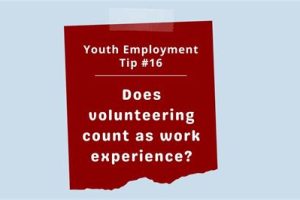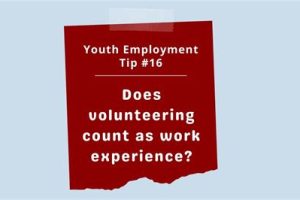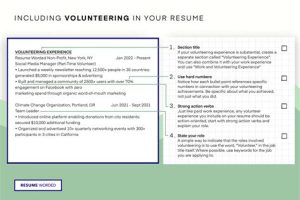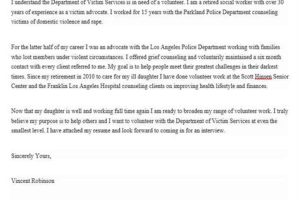Table of Contents
Wondering where to include your volunteer work on your resume? Find out the best placement for your volunteer experience and how to highlight it effectively. Enhance your chances of landing a job by showcasing your commitment, skills, and community involvement in the right section of your resume.
When it comes to crafting a stellar resume, showcasing your volunteer work can be just as important as highlighting your professional experience. Not only does volunteering demonstrate your commitment to making a positive impact in your community, but it also showcases your transferable skills and valuable attributes that employers are seeking. By strategically placing your volunteer work on your resume, you can effectively capture the attention of hiring managers and position yourself as a well-rounded and socially conscious candidate.
Introduction
In today’s competitive job market, having volunteer experience on your resume can give you a significant advantage. Employers value candidates who are not only skilled in their field but also actively contribute to their communities. However, it can be confusing to determine where to include this valuable information on your resume. In this article, we will explore the best ways to showcase your volunteer work and highlight its impact on your professional profile.
Why Include Volunteer Work on Your Resume?
Volunteer work is not just an opportunity to give back; it also provides numerous benefits for your professional development. Including volunteer work on your resume can demonstrate your commitment, dedication, and ability to work well with others. It showcases your skills beyond your professional experience and portrays you as a well-rounded individual with a genuine interest in making a positive impact.
How to Organize Your Resume
When it comes to organizing your resume, there are several options for incorporating your volunteer work. The two most common approaches are:
1. Chronological Order
Including volunteer work in the chronological order means listing it alongside your professional experiences in reverse-chronological order. This method is effective when your volunteer work aligns with your career goals or demonstrates relevant skills. By placing it under each corresponding job entry, you can showcase how your volunteer work complemented and enhanced your professional growth.
2. Separate Section
If your volunteer work is extensive or diverse, it may be more effective to create a separate section dedicated to it. This approach allows you to highlight your volunteer experiences in a concise and impactful manner. By giving it its own section, you draw attention to the valuable skills and qualities you gained through your volunteer work.
Formatting Your Volunteer Work
Regardless of the approach you choose, there are some formatting guidelines to follow when including volunteer work on your resume:
1. Use Clear Headings
When incorporating volunteer work, use clear headings such as Volunteer Experience, Community Involvement, or Non-Profit Work. These headings make it easy for employers to identify and understand your volunteer activities.
2. Include Relevant Details
Provide specific details about each volunteer experience, such as the organization’s name, your role, the duration of your involvement, and any notable achievements or projects you contributed to. This information helps employers gauge the scope and impact of your volunteer work.
Highlighting Transferable Skills
Volunteer work often imparts valuable transferable skills that can benefit your professional career. When describing your volunteer experiences, focus on highlighting these skills, such as leadership, teamwork, communication, problem-solving, or project management. By emphasizing these skills, you demonstrate to potential employers how your volunteer work has equipped you with the abilities necessary to excel in the workplace.
Showcasing Impact and Results
Employers are interested in the results and impact of your volunteer work. Quantify your achievements whenever possible to showcase tangible outcomes. For example, you can mention how many people you helped, the amount of funds you raised, or the percentage increase in community engagement as a result of your efforts. These measurable results provide concrete evidence of your effectiveness and commitment.
Tailoring Your Volunteer Work to the Job
When applying for specific positions, it’s essential to tailor your resume to match the job requirements. Analyze the job description and identify skills or experiences that overlap with your volunteer work. Highlight these relevant aspects of your volunteer experience to demonstrate your suitability for the role. By aligning your volunteer work with the desired qualifications, you increase your chances of standing out as a strong candidate.
Providing References and Contact Information
If possible, include references from your volunteer organizations. These references can vouch for your character, work ethic, and the impact you made during your time there. Also, consider providing contact information for the volunteer organizations or individuals who supervised your work. Employers may want to verify the details of your volunteer experience, and having this information readily available shows your professionalism and transparency.
The Importance of Authenticity
While it’s crucial to present your volunteer work effectively on your resume, it’s equally important to be genuine and truthful. Only include volunteer experiences that you have genuinely participated in, as employers may ask about them during interviews. Authenticity is highly valued by employers and can significantly contribute to building trust and credibility.
Conclusion
Volunteer work brings value to your professional profile by showcasing your skills, passion, and dedication. Whether you choose to integrate it chronologically or create a separate section, clearly highlight your volunteer experiences along with their impact and outcomes. By aligning your volunteer work with the job requirements and providing references when possible, you enhance your chances of impressing potential employers. Remember to be authentic and truthful, as these qualities are essential in building a successful career based on meaningful contributions.
Where Do You Put Volunteer Work On Resume
Incorporating volunteer work into your resume is an effective way to showcase your commitment to community engagement and highlight the valuable skills you have gained through volunteering. By strategically placing volunteer experiences throughout your resume, you can demonstrate your dedication and initiative to potential employers. Here are some key areas where you can include volunteer work:
1. Summary or Objective Statement
Start by including volunteer work in the summary or objective statement at the beginning of your resume. This placement immediately signals your commitment to community engagement and showcases your proactive nature. By highlighting your volunteer experience right at the beginning, you can grab the attention of employers and emphasize your dedication to making a positive impact.
2. Experience Section
Create a separate section within your resume titled Volunteer Experience to emphasize and highlight your involvement in various organizations or causes. Structure this section similarly to your professional work experience, providing details such as the name of the organization, your role, the duration of your involvement, and specific responsibilities or achievements. This format allows employers to easily identify your volunteer experiences and understand the valuable contributions you have made.
3. Skills Section
Integrate the skills you have gained through volunteer work into a dedicated section of your resume’s skills area. This demonstrates to employers that you possess valuable attributes such as leadership, teamwork, communication, and problem-solving abilities – all highly sought after in the professional world. By explicitly highlighting these skills, you can showcase your versatility and adaptability, making you a desirable candidate for any position.
4. Professional Affiliations
If you actively participate in a specific professional association or community organization as a volunteer, include this information in its respective section on your resume. Whether it’s a membership to a professional society or a voluntary role within a local community group, showcasing these affiliations can add credibility and demonstrate your commitment to professional development. Employers appreciate individuals who actively contribute to their field and engage with their communities.
5. Relevant Experience
If your volunteer work is closely related to the industry or job you are applying for, consider including it within your experience section alongside your professional work history. Treat it just like any other job, outlining your position, responsibilities, accomplishments, and the impact you had on the organization or cause you worked with. This demonstrates your ability to transfer your skills and experiences from the volunteer context to a professional setting.
6. Leadership Roles
Highlight any leadership positions held during your volunteer work. Employers highly value individuals with leadership abilities, and being able to demonstrate your experience in leading a team or project within a volunteer context can enhance your overall resume. Showcase your ability to motivate and inspire others, as well as your capacity to take charge and make impactful decisions.
7. Honors and Awards
If you have received any accolades, recognition, or awards for your volunteer work, create a dedicated section for these achievements. This highlights your dedication and the impact you have made, showcasing your commitment to excellence even in unpaid endeavors. Employers appreciate individuals who go above and beyond, and these honors and awards validate your exceptional contributions.
8. Additional Information
Include any other relevant information related to your volunteer work, such as relevant certifications, training, or workshops you participated in during your time as a volunteer. This demonstrates your willingness to continually learn and improve, which is highly desirable to employers. It shows that you not only dedicated your time and effort to a cause but also actively sought out opportunities to enhance your skills and knowledge.
In conclusion, incorporating volunteer work into your resume is essential for showcasing your commitment, skills, and accomplishments. By strategically placing volunteer experiences throughout your resume and highlighting them in various sections, you can effectively demonstrate your value as a candidate and increase your chances of securing employment opportunities.
When it comes to creating a professional resume, showcasing volunteer work can be a valuable addition that demonstrates your commitment to making a positive impact on society. Including volunteer work on your resume allows potential employers to gain insight into your character, values, and dedication beyond your professional experience.
1. Create a separate section: To ensure that volunteer work stands out on your resume, it is advisable to create a dedicated section specifically for this purpose. This allows you to highlight your involvement and contribution to various organizations or causes.
2. Place it after your professional experience: It is generally recommended to place the volunteer work section after your professional experience section. This ensures that your work history takes precedence while still giving your volunteer activities the recognition they deserve.
3. Provide a clear heading: Use a clear and concise heading, such as Volunteer Experience or Community Involvement, to introduce the section. This helps employers quickly identify and locate your volunteer work on your resume.
4. Include relevant details: For each volunteer position, provide a brief description of the organization, your role, and the duration of your involvement. Emphasize any key accomplishments or responsibilities that are relevant to the job you are applying for.
5. Highlight transferable skills: Volunteer work often requires a diverse range of skills, such as communication, leadership, teamwork, and problem-solving. Highlight these transferable skills in bullet points or through concise descriptions to demonstrate their application in a non-professional setting.
6. Quantify your impact: Whenever possible, quantify the impact you made during your volunteer work. For example, if you organized a fundraising event, mention the amount of money raised or the number of attendees. This helps employers understand the scale and success of your contributions.
7. Tailor it to the job: Just like your professional experience, tailor your volunteer work section to align with the requirements of the job you are applying for. Focus on volunteer experiences that showcase skills or experiences directly relevant to the position.
8. Keep it concise: While it is important to include volunteer work on your resume, be mindful not to overwhelm your application with excessive information. Select the most significant and recent volunteer experiences to include, ensuring they enhance your overall qualifications rather than overshadowing them.
9. Update regularly: As you continue to engage in volunteer work, make sure to update your resume accordingly. Regularly review and revise your volunteer section to reflect your most recent experiences and accomplishments.
10. Be prepared to discuss: Finally, be prepared to discuss your volunteer work during interviews. Employers may ask about your motivations, experiences, and the impact you made. Be enthusiastic and articulate in describing your volunteer work, as it can provide valuable insight into your character and values.
By strategically placing and effectively showcasing your volunteer work on your resume, you can present yourself as a well-rounded candidate who is not only dedicated to professional growth but also committed to making a positive difference in the community.
Thank you for taking the time to read our blog post on where to include volunteer work on your resume. We hope that you found the information provided helpful and insightful. In this closing message, we would like to summarize the key points discussed throughout the article and provide you with some final thoughts on the topic.
First and foremost, it is essential to recognize the value of volunteer work and understand how it can benefit your resume. Whether you have volunteered in your local community, at a nonprofit organization, or even internationally, these experiences can demonstrate important skills and qualities to potential employers. By including volunteer work on your resume, you are able to showcase your dedication, teamwork, leadership, and adaptability – all of which are highly sought after in today’s job market.
When deciding where to place your volunteer work on your resume, there are a few options to consider. If your volunteer experience directly relates to the position you are applying for, it is recommended to include it within your work experience section. This allows you to highlight your relevant skills and accomplishments in a professional manner. On the other hand, if your volunteer work is more general or does not directly align with the role you are pursuing, it may be better suited under a separate section titled Volunteer Experience or Community Involvement. Either way, ensure that you provide specific details about your responsibilities, achievements, and the impact you made during your volunteer work.
In conclusion, volunteering can greatly enhance your resume and make you stand out to potential employers. It not only demonstrates your commitment to making a positive impact but also showcases valuable skills that can transfer to the workplace. When deciding where to include your volunteer work on your resume, consider its relevance to the position and choose a format that best highlights your experiences. Remember to provide specific details and quantify your achievements to make them more impactful. We wish you the best of luck in incorporating your volunteer work into your resume and in your future job search!
.
When it comes to where you should put volunteer work on your resume, there are a few options to consider:
Include a separate Volunteer Experience section: If you have extensive volunteer experience or if it is highly relevant to the job you are applying for, creating a separate section specifically for volunteer work can be a good choice. This allows you to highlight your volunteer experience and demonstrate your commitment to community service.
Integrate volunteer work into your Work Experience section: If your volunteer work closely aligns with your professional experience or demonstrates transferrable skills, you can incorporate it into your Work Experience section. Treat it similarly to paid positions by listing the organization, your role, and the dates of your involvement.
Include volunteer work under relevant job descriptions: Another option is to list your volunteer work under the corresponding job descriptions in your Work Experience section. This helps to showcase how your volunteer experience directly relates to your professional roles and responsibilities.
In any case, it is essential to provide specific details about your volunteer work, such as the organization’s name, your role or responsibilities, the duration of your involvement, and any notable achievements or outcomes. This information helps employers understand the value you brought to your volunteer positions and how it may translate to the desired job.
Remember to tailor the placement and level of detail of your volunteer work based on its relevance to the position you are applying for. Prioritize the information that showcases your skills and experiences most effectively for the specific job.






